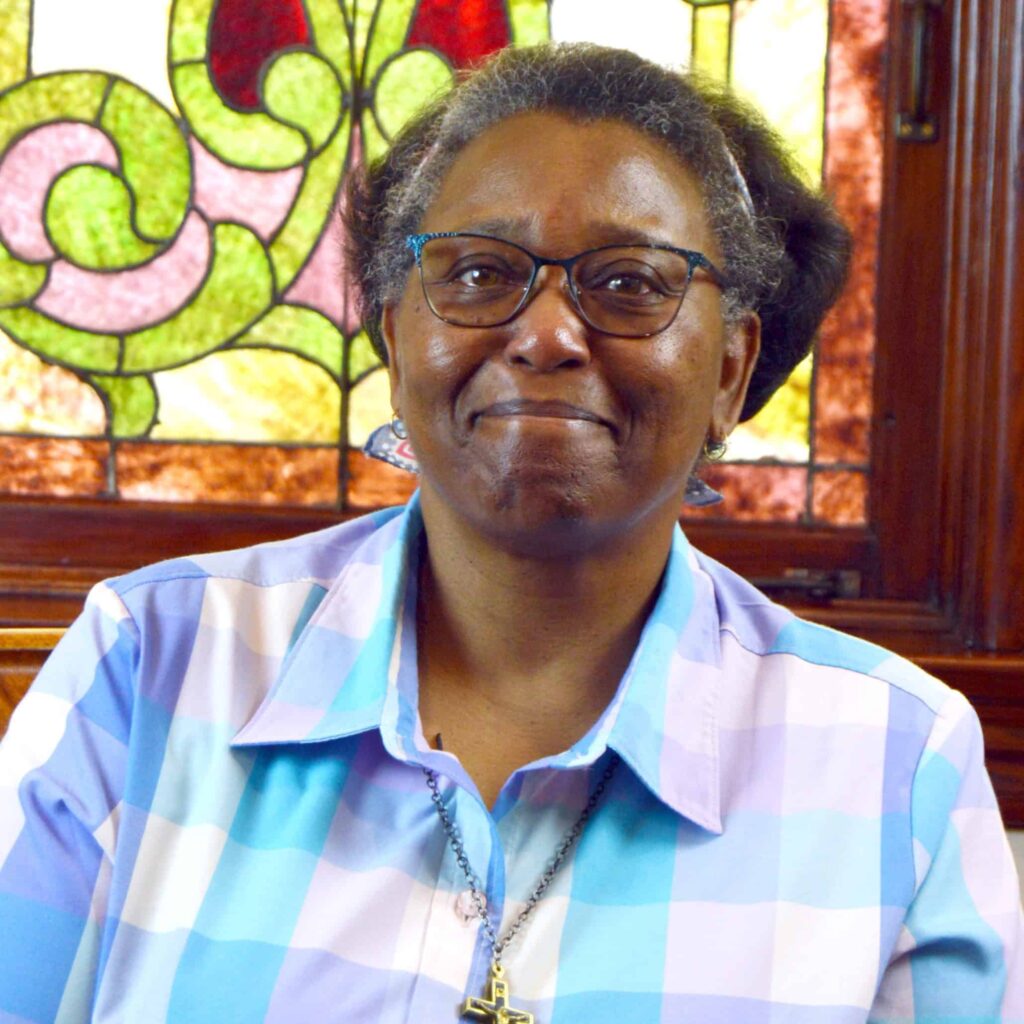During the Fuel the Body, Fuel the Soul meeting on April 11th, Sister Rosemary Casaleno showed participants her recipe for healthier eggplant parmesan. Following the recipe, Sister Philonise Keithley of the Sisters of St. Joseph of Concordia gave a presentation entitled, “Jesus, Women and the Call to Radical Love.” Find the eggplant parmesan recipe and a recording of Sister Philonise’s presentation below!
Fuel the Body, Fuel the Soul is a monthly series held on the second Thursday of the month. Each Zoom session features an introduction to a healthy recipe presented by a sister, a presentation focusing on a spiritual topic and discussion and prayer with a community of young women from around the country. Register once for any/all sessions. There is no cost to attend.

Eggplant Parmesan Recipe
by Sister Rose Casaleno, CSJ

Time: 55 minutes
Servings: about 4
Ingredients:
- 2 tbs olive oil
- 1 clove minced garlic
- 1 tbs parmesan cheese
- 1 tbs basil
- 1/2 cup shredded mozzarella cheese
- 1 medium-sized tomato
- 1 eggplant
Directions: Cut the tomato into thin slices. Peel the eggplant and cut it into 1/4 inch slices. Mix together the olive oil and garlic. Brush eggplant slices with olive oil and garlic mixture on both sides and place on a baking sheet. Bake the eggplant slices at 425° for 15 minutes, watching carefully. Flip slices and cook for an additional 5 minutes. Layer the baked eggplant slices, tomato slices, basil, parmesan and mozzarella in an oven-safe dish. Top with the remaining cheese. Cover and bake for 20 minutes. Uncover and bake for an additional 5 minutes. Enjoy!

Jesus, Women and the Call to Radical Love
by Sister Philonise Keithley, CSJ
In the glorious octave of the risen Lord, or what we call Easter, I would like to share with you a bit of scripture that I have been pondering in my heart and turning over in my imagination for probably a year—and where my reflection has come thus far. This reflection is couched within the crucifixion and the burial. My focus seemed to narrow in on the women there. So, I started with Mark.
There were also women looking on from a distance. Among them were Mary Magdalene, Mary the mother of the younger James and of Joses, and Salome. These women had followed him when he was in Galilee and ministered to him. There were also many other women who had come up with him to Jerusalem.
Mark 15:40-41
Now, I am a person who has a very curious nature. I stay on Google; I want to know about this and more about that. And so I decided I wanted to explore these women that Mark talks about who came with Jesus from Jerusalem. So I went to Luke next, to see what he has to say about them.
Luke says, in chapter 23, verse 27, “A large crowd of people followed Jesus, including many women who mourned and lamented him.”
I read a commentary about this reading. The commentary told me, at the time of Jesus, there were people referred to as professional mourners. I can remember my father telling me about professional mourners when I was a little girl. I thought he was joking me.
Professional mourners were people, women coming upon a scene of sorrow, such as a family in distress over the loss of a loved one. And they began to moan and wail and mourn with the family. Sometimes they didn’t even know the family. So I’m thinking, these people probably never even heard of Jesus.
Further in Luke’s account around verse 49, he says, “…but all his acquaintances stood at a distance, including the women who had followed him from Galilee and saw these events.” I went on to Matthew.
There were many women there, looking on from a distance, who had followed Jesus from Galilee, ministering to him. Among them were Mary Magdalene and Mary the mother of James and Joseph, and the mother of the sons of Zebedee.
Matthew 27:55-56
Mary Magdalene is mentioned several times in these readings. She also comes up at the burial site. She’s called the apostle to the apostles, but that is a whole other reflection. But I tell you, I became captivated by these women with no names, standing at a distance, looking on as our Lord faced the most raw, humiliating, devastatingly unbearable moment of his life. The women stood, watching from a distance, no words, no signs, or protests, no wailing, no moaning, only standing still, silently watching.
Who were they? My mind just wouldn’t let go of Mark’s words. “There were also women looking on from a distance.” Women who had come with him to Jerusalem. Who were these women who had broken the social protocol of the day, to come with him? Did their husbands come? Did they bring the kids? Did they make sure that their homes were in order before they left? Did they ask permission of the elders?
As a Sister of St. Joseph, I have been formed and molded in the spirituality of St. Ignatius. Ignatius instructs us to use our senses to fully immerse, as we imagine the surroundings of the scripture of our contemplation, to find God in all things. So following the guide of Ignatius, I began weaving my way through this crowd.
Some indeed, had brought their children but the children did not seem to distract. One child is held tightly, being rocked into a dream, as her mother nurses her to sleep. Another sits, making circles in the dirt. And yet another stood on its toes, arms stretched upward and outward, in it’s silent action, begging a younger woman to be lifted high. The younger woman I saw, she was the girl that everyone declared dead, but Jesus raised her from her deathbed. I noticed behind her, way back, making her way to the front, was the woman that had the issue of blood. Of course, as very good friends, Mary and Martha were both there, tears streaming down their faces.
And the woman at the well, the woman whose chance meeting over a cup of water. And the bold and brazen one who crashed the party, focused on Jesus, who walked right up to the front, washed his feet and dried it with her hair. They were both there in the crowd. And my five aunties—married, single, and widowed—who along with my mother leaned into and on the love of Jesus and became a village to raise together a university professor, a lawyer, a journalist, a parole officer, a pharmaceutical tech instructor, a high school principal and a little old chaplain sister. There were many there. Many, many more than I’ve heard about. And they were standing there silently, all very clear that they were in the right place, and they belonged.
I looked around, and I had this epiphany. The names were never what was important. What was important was that they—we—held a common thread. Our encounters with this dying body, dangling before us on a rough, splintered thing, had embraced each one of us with a radical love. A love that delivered, inspirited, emboldened a deep love that moves stones of fear of public judging, opinion and old traditions, to transformative experience of new life, courage and energy. That moved hopelessness and replaced it with a new sense of spiritual meaning and purpose.
They had experienced—we had experienced—a soul transformation. A soul transformation that defied everything that we knew and changed the trajectory of our lives forever. We were alive. We did not travel with him to be recognized, or even remembered, or named. We traveled with him as an expression of our profound gratitude. We did not come to protest, or even wail and moan. Our purpose was not to change the events. Can you imagine the fortitude it must have taken to travel with him? We came. You and me. We came to bear witness, to be present, to be with Jesus—as he comes to continue to be with us—to assure him that we will follow him all the days of our lives. And why? Because he loves, and we believe. Amen.